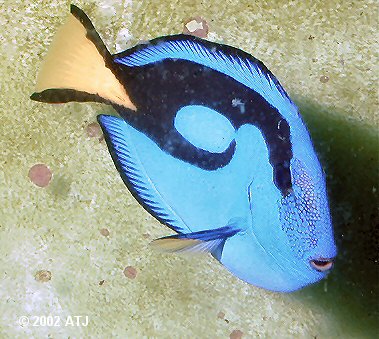
The Blue Tang in April 2002
Tuesday 8 May 2007
It was a sad day indeed when I found my blue tang dead. At the time it died, I'd had the fish for 8 years, 8 months and 16 days. It had been unwell for more than a month but I was unable to determine what was wrong with it.
This fish was purchased from Strictly Aquariums in Yagoona along with two other blue tangs. At the time of purchase this fish was 30mm Total Length, with the other two fish at 40 and 25 mm TL respectively. These three blue tangs were effectively the first fish in a four foot tank I was using as a quarantine tank while waiting for my six foot tank to cycle. I say effectively as I had a Eibli angelfish that only survived a couple of weeks. The three tangs spent nearly five months in the four foot quarantine tank, including a period of three weeks when we went to the US and a friend visited daily to feed them on flake food.
When the six foot tank was ready, the three tangs were moved and they settled in quite well. Two weeks later I added a fourth tang. All four blue tangs got on very well for the next three years and nine months. All the tangs grew well and by October, 2001, this blue tang was around 80 mm TL, and its companions were 90, 75 and 50 mm TL, respectively,
In October, 2001, the good relations between the tangs broke down. The largest tang became very aggressive to this tang, which was the second largest. The attacks were relentless and continued for two weeks. This tang was not able to feed and I was only able to catch it when it was weakened and highly stressed.
I moved this tang to my three foot quarantine tang where it "sat" in the corner of the tank for four days without feeding. It was breathing heavily and was badly cut from the encounters with the other tang. Eventually, it ventured out and started to feed. Gradually, it grew more and more confident and was soon back to normal and the cuts healed.
The tang spent four and a half months in the quarantine tank until I got another six foot tank ready. During this time it grew another couple of centimetres in length, and actually grew faster than the tang that had been attacking it.
In March 2002, I moved the tang to my new 180 gallon FOWLR along with three wrasses (, Coris gaimard, ) and four Psuedanthias spp.. (3 , 1 ), but I lost one of the P. pictilis from shock after the move.

The Blue Tang in April 2002
These fish did very well together until May 2002 when I introduced a and a . Unfortunately, I had not quarantined the Forcipiger long enough, just 28 days since I had caught it at Seal Rocks, NSW. A week after introduction, the tang, Heniochus, Forcipiger and Pseudanthias all showed signs of "Ich". The three wrasses showed no signs at all. I attempted to catch the infected fish so I could treat them in the quarantine tank, but had no luck at all and realised I'd have to sit it out. I soaked the food with garlic juice in the hope that this may help. Over the next three months, the fish went through six to eight cycles of "Ich". Two of the Pseudanthias didn't make it and neither did the Heniochus, however, the blue tang and the Forcipiger made full recoveries and by September, 2002, neither showed any further signs of "Ich".

The Blue Tang in January 2003
In February and March 2003, the three blue tangs in the old six foot tank died mysteriously. They each died a week or so apart from each other and the only signs were difficulty swimming.

The Blue Tang in May 2006
The blue tang did very well and was healthy until early 2007. In late January 2007, the tang started behaving strangely. It would hide most of the time, wedged in the rock work. When it did come out into the open, it had trouble swimming as if it couldn't maintain its balance. It was still eating a small amount each day but this gradually decreased until late February when it didn't come out at all.
On one morning in at the start of March 2007, I came in to the fish room to find the blue tang swimming around as if nothing was wrong. It was back to normal, swimming and eating without any problems at all. The fish continued to behave normally for all of March.
In early April, the blue tang started behaving oddly again, as before. This time it was coming out less frequently and feeding less. For the last two weeks of its life it didn't come out at all. although I could still see it wedged in the rockwork. In the morning of 8 May 2007, I found the fish dead. Interestingly, there were no marks on the body at all and nor had it lost any weight or condition.
I am at a complete loss as to the cause of death. My unsubstantiated theory for its death is some kind of brain disorder, akin, but not related to, "mad cow" or dementia. I suspect something similar happened to the other tangs some 5 years earlier. Perhaps there was a nutritional issue. I guess I'll never know.